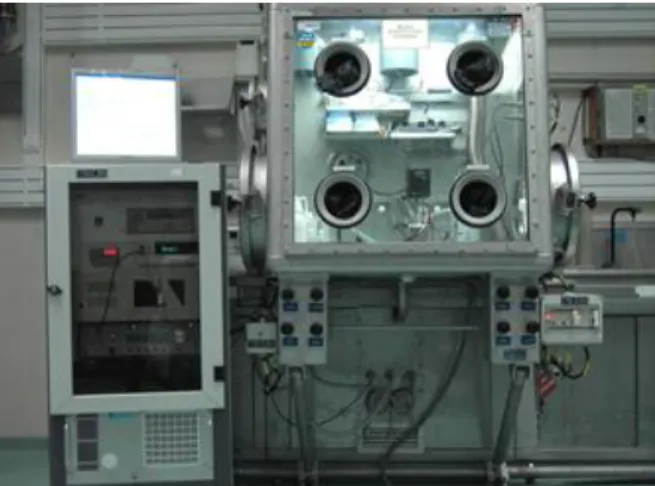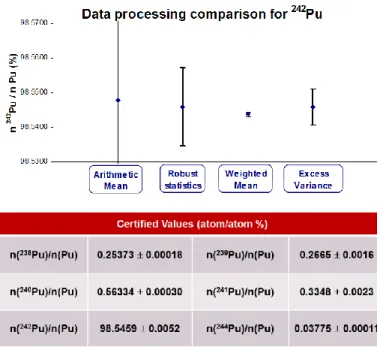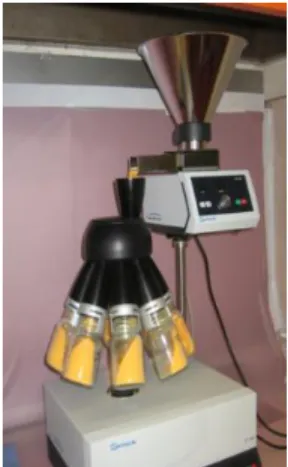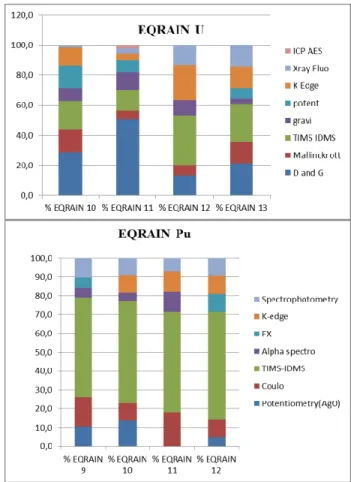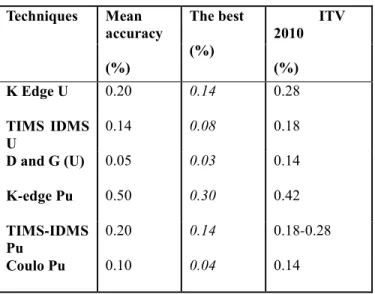HAL Id: cea-02500810
https://hal-cea.archives-ouvertes.fr/cea-02500810
Submitted on 6 Mar 2020
HAL is a multi-disciplinary open access
archive for the deposit and dissemination of
sci-entific research documents, whether they are
pub-lished or not. The documents may come from
teaching and research institutions in France or
abroad, or from public or private research centers.
L’archive ouverte pluridisciplinaire HAL, est
destinée au dépôt et à la diffusion de documents
scientifiques de niveau recherche, publiés ou non,
émanant des établissements d’enseignement et de
recherche français ou étrangers, des laboratoires
publics ou privés.
D. Roudil, C. Rigaux, C. Rivier, M. Crozet, I. Solinhac
To cite this version:
D. Roudil, C. Rigaux, C. Rivier, M. Crozet, I. Solinhac. The challenges of chemical metrology in the
fuel cycle the role of CETAMA. Global 2015, Sep 2015, Paris, France. �cea-02500810�
The challenges of chemical metrology in the fuel cycle: the role of CETAMA
D. Roudil; C. Rigaux; C. Rivier; M. Crozet; I. Solinhac
CEA Nuclear Energy Division, Marcoule Center Radiochemistry & Processes Department, F-30207 Bagnols sur Cèze Cedex, France
Tel : +33466796329 Email : danielle.roudil@cea.fr
Abstract –The accuracy of analysis results at each step of the nuclear fuel cycle is of prime importance for nuclear
material control and forensic investigations.
The IAEA specifies several target values for measurement uncertainties in monitoring nuclear materials. Some of these represent serious challenges for industrial processes.
To improve and guarantee accuracy and performance, analysis laboratories rely on certified reference materials (CRM) for measurement quality control, for the calibration of analytical instrumentation, and when spiking samples for elemental assay by isotope dilution analysis. Proficiency tests such as the CETAMA EQRAIN program are tailored for laboratory performance comparisons. In the future, the nuclear fuel cycle and in particular the reprocessing industry and R&D will require new standards and methods to comply with high-content plutonium fuel and new extraction solvents.
Some recent involvements of the CETAMA concern:
New high chemical purity CRM development or enlarged recertification for actinide analyses,
Enhanced certification methodology,
Feedback on performance assessment,
Support in uncertainty assessments and analytical method standardization.
I. INTRODUCTION
Each step of the nuclear fuel cycle involves chemical analysis, and has to follow regulatory or customer requirements.
In the field of nuclear energy production and the associated closed fuel cycle, industrial recycling plants and R&D facilities are subject to analytical monitoring to meet regulatory criteria, thus ensuring both secure facilities and non-proliferating processes. Analytical requirements are established at national levels and at the European level by EURATOM and the IAEA.
Control of nuclear materials is based on accurate knowledge of the quantities and grades of nuclear material present in facilities and regarding material transfers between facilities. This knowledge is obtained by direct nondestructive measurements as well as by destructive sample analysis, the latter having the advantage of providing more, and for most of them very, accurate measurements of the material quantities present in solution. Safeguards verification is based on ‘operator-inspectors’ comparisons.
Measurement results are only truly comparable when they have a stated traceable uncertainty.
In the future, new requirements are foreseen in relation to the likely evolution of the nuclear context, with on the one hand recycling of irradiated fuels richer in plutonium and, on the other, nuclear material analysis in a decommissioning context. The control of nuclear matter accountancy will be strengthened in order to limit proliferation and safety/criticality risks.
One of the principal missions of the CEA Committee for the Establishment of Analysis Methods (CETAMA) is to promote best analytical practices in French and European nuclear laboratories, providing reference materials to meet analytical needs as well as organizing inter-laboratory comparisons. Very high quality measurement standards are necessary to obtain accurate results and to perform reliable and accurate plutonium and uranium assays during fuel cycle operations.
At the same time, CETAMA has implemented a program known as EQRAIN (from the French acronym for “Quality Assessment of Analysis Results in the Nuclear
Industry”) focusing on uranium or plutonium assays in nitric solution, traces, and more recently ion analysis in water matrix.
Inter-laboratory comparisons provide laboratories with an opportunity to evaluate their performance, to check for possible deviations and, if necessary, to implement the appropriate corrective actions.
II. CHEMICAL ANALYSIS AND METROLOGY: CONTEXT AND
CHALLENGES
At each step of the fuel cycle, an analytical check is ensured by one or more centralized industrial laboratories. Among their missions is the need to guarantee the accuracy of analysis results for:
Quality control of products
Control of material flow
Nuclear material follow up
Safety and Environmental controls
U, Pu flow balance,
Nuclear material accountancy
R&D chemical analysis is involved at different steps of a development project, from the understanding of chemical phenomena and interactions through the piloting of small scale processes, and at a different level of information, from macro to nano-sizes.
The quality of analysis results depends on their precision (reproducibility with minimum dispersion) and trueness (closeness to the true value). Precision can be determined internally by measurements within each laboratory. Trueness depends mainly on certified reference materials through the use of separate methods based on different principles carried out by different operators, and on the participation in inter-laboratory comparisons. There is a special reliance on control assays using reference materials as similar as possible to the samples analyzed. Certified reference materials (CRM) should be mainly pure substances and can serve as the basis for the metrological traceability scheme.
By consensus, the definition of a reference material is described in [1]:
- Reference material (RM): material, sufficiently homogeneous and stable with reference to specified properties, which has been established to be fit for its intended use in measurement or in examination of nominal properties.
- Certified reference material (CRM): reference material, accompanied by documentation issued by an authoritative body and providing one or more specified property values
with associated uncertainties and traceability, using valid procedures.
Analytical requirements are established at national levels and at the European level by EURATOM and the IAEA. For Nuclear Material Accountancy, EURATOM specifies compliance to the most recent international standards and systematic inclusion in the results of the estimates of random and systematic errors.
In 2000 and 2010, International Target Values for Measurement Uncertainties in Safeguarding Nuclear Materials (ITV) were defined by the IAEA, based on the work of ESARDA (European Safeguards Research and Development Association) [2]. These values represent estimates of the state of practices which should be achievable under routine measurement conditions.
Currently in the chemical metrology field, apart from isotopic reference materials provided by the EC-JRC- Institute for Reference Materials Measurements (IRMM) in Europe, and the CEA LNHB lab in France for radioactive activity, no structured traceability schemes exist for the elementary and isotopic analysis of actinides and other radionuclides, because none of the National Metrology Institutes is able to produce references in this field. They do not have the facilities to accept nuclear materials in their laboratories. However, some key institutes such as the IAEA and national nuclear institutes have developed their own quality control tools.
The improvement of the certified reference material values and uncertainties is one of the challenges which chemical metrology must face, given future nuclear requirements. The controls need to be supported by accurate and comparable measurements which in turn have to rely on defined references. Clearly, long term credible comparability can only be guaranteed by making all measurements traceable to the same long-term stable references. The development of CRMs has therefore to be pursued [3], and close cooperation between Reference Materials Producers has to be strengthened.
Different techniques are widely used by the nuclear laboratories, applying validated methods. To improve their performances, in particular the consistency of uncertainty values, proficiency tests (PTs) are periodically organized by European laboratories such as the IRMM, IAEA Nuclear Material laboratory (NML), and CETAMA.
TIMS (thermo-ionization mass spectrometry) is the reference technique for isotopic composition and concentration determination, through isotope dilution (IDTIMS). It has been progressively replacing traditional chemical methods (potentiometry, gravimetric analysis, etc.) which generate more effluents and wastes, despite
their good results. Furthermore, TIMS techniques provide now results between the best.
However, to obtain traceable measurement results with very low uncertainties, isotopic standards and spikes are indispensable. Suitable materials are currently commercially available for uranium and plutonium.
Nondestructive methods include emission spectrometry and X-ray or visible absorption spectrometry. The trend toward a wider use of physical methods has been confirmed: these provide advanced analytical performance (e.g. K-edge) and are advantageous in terms of productivity, minimal effluents, and compliance with environmental standards.
At the same time, conventional chemical balance methods are still the most effective, especially coulometry, acknowledged as a primary analysis method by the Comité Consultatif pour la Quantité de Matière (CCQM) and which provides accurate measurement results with low uncertainties, when applied on high purity samples.
But this technique is currently used by only a few laboratories in the nuclear field (fig. 1). In the future, it should be necessary to improve the accuracy of this technique when applied to nuclear reference samples.
Fig 1: Nuclearized coulometry equipment in LAMMAN laboratory
III. CETAMA PARTICIPATION An efficient promotion of best analytical practices implies the establishment of common validated methodologies. And thus structured traceability scheme, proficiency test schemes have to be set on, dedicated in particular to nuclear analytical needs.
III.A. Nuclear certified reference materials: contribution
Reference materials are essential tools for laboratories to evaluate and validate the performance of their testing procedures.
Analysis laboratories rely on CRMs for quality control of their measurements, for calibration of analytical instrumentation, and for spiking of samples for elemental assay by isotope dilution analysis.
More generally, in the nuclear fuel cycle, these materials are used for the monitoring of nuclear materials, process controls, monitoring of the environment...
To meet the needs of nuclear laboratories, the CETAMA has offered three types of certified reference materials for more than 30 years:
High purity materials certified in major elements (U, Pu, Np)
Certified matrix materials intended primarily to assess performance characteristics (trueness, precision) of an analytical method. These matrices are representative of different steps of the fuel cycle (e.g. uranium ore concentrates).
Materials certified in isotopic composition (U, Pu) to calibrate isotopic analysis instruments (e.g. TIMS, ICPMS). They can also be used as isotopic "tracers", including monitoring of chemical reactions (e.g. extraction yield) but also as standards for analysis by isotope dilution.
The CETAMA catalog offers about thirty four different CRMs.
Depending on laboratory needs, material evolutions or stability, and stock shortage risk, the different CETAMA CRM types are updated as described in the 34 and 35 ISO guides [4-5].
Reference material production is organized in 2 main steps: fabrication and then the certification process.
The fabrication of a new reference material with high purity requires purified raw materials and a suitable safe working environment in a nuclear facility.
The mean duration for these processes is about 4 years, and may require the collaboration of different European or national laboratories.
The associated uncertainties of a CRM certified value as given by the certificate are of prime importance for calibration processes and, finally, analysis result trueness. According to ISO guide 35, this certification can be conducted through specific inter-laboratory comparisons, with selected expert laboratories and dedicated techniques and methods.
Different statistical approaches are used to assess a reference value and its uncertainty: arithmetic mean, weighted mean, robust mean and more recently the “Weighted mean and excess variance” approach recommended by the CCQM (Comité Consultatif pour la Quantité de Matière), the international committee for
chemical metrology. This approach is based on the procedures used for the processing of international Inter-laboratory Comparisons [6].
This approach was chosen for the first time by CETAMA for the certification of its 242Pu isotopic reference material,
produced in 2012 [7]. It consists in the determination of the weighted mean of the results, the weight (wi) being
calculated depending on the measurement uncertainty provided by each participant (ui) and also on the spread of
the laboratory results, symbolized by λ in Eq 1:
wi = (ui2+λ)-1/((uj2+ λ)-1) (1)
The mass spectrometry thermal ionization method (TIMS) was recommended as the analytical technique for certification. Given the wide differences among the uncertainty values provided by the participants, the use of a weighted mean approach was necessary. The discrepancies in the measurement uncertainties provided by the laboratories were explained by the methodologies used for the TIMS calibration and by the number of replicates performed.
The method also suits cases of inconsistency between some isotopic laboratory results.
After determining certified values and their associated uncertainties by the Excess-Variance approach, a certificate was established for this new 242Pu reference material [8].
Figure 2 gives an example for isotope 242.
Fig 2: 242Pu certification results
Thanks to this new approach, the final relative uncertainty for the 242Pu ratio value, lower than 0.3%, takes into
account the four expert laboratory estimations, and all the certification test parameters.
Solid matrix CRMs are of major importance in the nuclear field because of the wide variety of materials within the fuel cycle, including wastes and safeguards and decommissioning and of their potential impact on measurement values. Mine and uranium ore concentrates are an example of this kind of sample, shown in figure 3. The homogeneity factor is in this case of paramount importance for global uncertainty evaluation.
.
Fig 3: Matrix CETAMA CRMs of CETAMA catalog: uranium “MIN F” ore (left) and “GRENAT” concentrate (right).
Here CETAMA, in collaboration with the IAEA NML, has undertaken an enlarged re-certification of one of its uranium ore concentrate (UOC) reference materials: the Feldspath ammonium matrix CRM certified in Fe, PO4
3-and SO42- concentrations normalized to uranate mass.
The first step concerned the homogeneous reconditioning of the samples, shown in figure 4. The experimental work was carried out by the analytical service at the AREVA Bessines site. The homogeneity was confirmed for U, Fe, Mg and Ca, considered as major elements for this test. According to [5], these homogeneity assessments were established on ten randomly selected ampoules, three sampling by ampoule and two analysis by samples. The relative uncertainty budget linked to the heterogeneity of the matrix, normalized to matrix mass, remains lower than 3%.
This low value is acceptable for a reference material, with a minor impact on final certified value uncertainty.
Fig 4: Feldspath CRM reconditioning
The second step of this certification concerned the inter-laboratory comparison conducted by expert laboratories either on major impurities or on rare earth element (REE) patterns. The statistical processing currently in progress will lead to a standard UOC certified in:
concentration ratio to U of 6 impurities: Mo, V, Zr, Fe, Ca and Mg, according to ASTM standard requirements,
REE pattern for safeguards and forensic issues. The weighted mean and excess variance approach was also retained for most of the impurity concentration certified values and uncertainty assessments.
Fig 5: Statistical processing certification for Fe concentration in the Feldspath UOC
For Fe impurities, the expanded concentration uncertainty (at k=2) deduced from expert laboratory values is about 0.87 mg.Kg-1U, in coherence with first certification data.
The global standard uncertainty for this element is thus 1.96mg.Kg-1 U, close to 4%, 1% coming from the analysis
uncertainty budget and 3% from matrix non-homogeneity and mass evolution in open system.
The uranium content of this matrix will be now certified, with an estimated concentration of 746.07 g.Kg-1UOC with
an homogeneity factor for this element better than 0.22%. The incoming nuclear reference materials are unique standards for nuclear analysis laboratories:
o 243Am spike in collaboration with IRMM
o Renewal of Pu assay and isotopic high purity reference materials thanks to collaborations between Military Application and Nuclear Energy Divisions of the CEA.
o PuO2 solid standards for X micro-analysis.
III.B. CETAMA EQRAIN program
III.B.1. Organization
Analytical approaches are validated by demonstrating that they are suitable for their intended objectives and meet the particular requirements of each unit.
In this analytical validation context and included in its main mission of promoting good analytical practices, the program known as EQRAIN has been implemented since 1987. The EQRAIN program has organized regularly inter-laboratory comparisons concerning the elemental analysis of uranyl and plutonium nitrate solutions, the analysis of trace elements in water, and last but not least, ion analysis (since 2014).
EQRAIN U and Pu analysis assays are basically proficiency tests, although they are not performed directly for the purpose of assessing the performance of the laboratories concerned.
Twenty EQRAIN trace round robins have been organized to date, based on multi-elementary solutions of 15 elements.
The data obtained from the EQRAIN inter-laboratory comparison program was processed using the robust statistical methods described in the ISO standard [9]. As the number of measurements per laboratory varied considerably, no distribution hypothesis was applicable. For this reason robust methods were used in the statistical processing, enabling the integration of all the data available including that considered as outliers under the criteria of a normal distribution, whilst minimizing the latter’s influence.
Weighted
mean Robust
stat.
ExcessFor each ampoule of a proficiency test, a table summarizes the data by laboratory code and by technique, following the criteria below:
o laboratory code number,
o the abbreviation of the method used, o the number of measurements “n”, o the mean of the measurements,
o the relative deviation compared to the reference value, expressed in %,
o the standard absolute uncertainty expressed by the laboratory for a given technique, at k=1,
o the relative expanded uncertainty of the laboratory expressed in % at k=2,
o the zeta score, from the uncertainty assessment of most of the laboratories, and the z score.
Existence of bias measurement is studied and validated according to NF- ISO 5725 standard: it is based on the difference between mean analysis and reference values, and estimated by its standard deviation.
III.B.2. Feedback
Concerning uranium and plutonium, the results compiled over recent years provide an interesting opportunity to note the trends in this type of analysis and to compare the accuracy and reproducibility of the main methods employed, be these for material balance inspection or process control. This statistical data processing highlights the progress made by laboratories in evaluating their measurement uncertainties.
This measurement method intrinsic performance evaluation is compared to the measurement uncertainty values established by IAEA for nuclear material balances (ITV2010) [10-11].
For each technique, trueness assessment was derived from the mean value of the absolute deviation from a reference value, without taking into account result values with an absolute Z or Zeta score higher than 2.
The trueness Jan and precision Fan of an analysis
method were evaluated from all pan measurements xijk
performed using this method by all the laboratories, and for all the U or Pu proficiency tests.
Trueness
an l ijk ijk anp
E
J
co n st
(2)with Eijk , the absolute value of Dijk expressed in %
Jan is expressed as a relative value (%).
Precision
an ijk ijk anp
X
Ur
F
(3)Fan is expressed in % with respect to the laboratory mean
value.
TIMS-IDMS, K-edge and potentiometry are the main techniques routinely used by the laboratories (fig. 6). They represent major contributions to the EQRAIN tests and the mean accuracy deduced can be considered as representative of the CETAMA laboratory network performances
Fig 6: U and Pu techniques in EQRAIN PTS
Overall results (see table 1) showed good agreement between EQRAIN U and Pu uncertainty values and corresponding ITV 2010 values obtained by the CETAMA network of laboratories. The mean accuracy deduced from EQRAIN tests was evaluated by quadratic sum, as recommended in [2].
However, the uncertainties given by the laboratories could include both systematic and random errors. We can therefore suppose that the EQRAIN mean values in Table I are slightly overestimated.
Table 1: U and Pu analysis performance feedback
Nevertheless it must be taken into account that the reference solutions used were pure and mono-elementary, leading to very favorable analysis conditions.
The feedback for the EQRAIN traces PTS highlights the performance of multi elementary ICP AES and MS methods for trace (mainly metal) measurements.
In addition to ISO 5725 and 17043 standards, the ISO 21748 [12] standard offers a methodology for associated results uncertainty evaluation, taking into account performance data from inter-laboratory comparison tests. The statistical processing of results also highlights potential difficulties in specific element determinations. The feedback seen from previous comparisons offers an experimental view of the advantages and limits of the techniques and methods versus the chemical elements and their concentrations to be determined. An original application was established, based on the accuracy profile validation method approach, for the impurities regularly studied in the comparison tests, beginning by U, Cd and B [13-14].
Depending on ICP techniques and implementation environment, such approach highlights influent parameters and quantifies this influence on the limit of quantification (LOQ):
For U a difference of at least 3 orders of magnitude was observable between ICP-MS and ICP-AES,
The degradation of the LOQ in case of a hot cell adaptation of the ICP-AES equipment is about 1 order of magnitude
Figure 7 illustrates these differences.
It is obvious that the parameters and criterions of the accuracy profile are not absolute values and cannot be generalized. They mainly depend on the analytical problem and objectives and their requirements in terms of validation.
Fig. 7: Comparison of U accuracy profiles in [13]
III.B.3. Perspectives
Main advantages of PTS inter-laboratory comparisons are:
The wide variety of matrices and analytes able to be covered by this tests,
The possibility of performance comparison.
But they need to be completed by certified reference materials because of certain disadvantages:
o No guaranties in terms of stability and traceability of the reference samples,
o They cannot be used for calibration.
The number of past exercises, the numerous regularly participating laboratories and the rigorous compliance with standards in force mean that the EQRAIN PTS programs now represent technical data resources.
Taking advantage of recent inter-laboratory comparisons for unique reference material certification, namely the UOC recertification and in the near future the Am243, new kinds of PTS exercises give laboratories an opportunity to evaluate their methods on these new materials.
Old EQRAIN uranium and plutonium ampoules are also used as reference materials.
Techniques Mean accuracy (%) The best (%) ITV 2010 (%) K Edge U 0.20 0.14 0.28 TIMS IDMS U 0.14 0.08 0.18 D and G (U) 0.05 0.03 0.14 K-edge Pu 0.50 0.30 0.42 TIMS-IDMS Pu 0.20 0.14 0.18-0.28 Coulo Pu 0.10 0.04 0.14
III.C. Reference documents
Industrial projects need validated analysis results, depending on the standards in force: a validated method is a standardized one or a well characterized method in terms of trueness, precision, limit of detection etc…based on CRM use and on CIL participation.
Standardization is generally based on a common methodology established by industrial and R&D laboratories. The standardization of good laboratory practices is a major advantage, considering the time and cost of implementation. In this context different kinds of reference documents are established in the CETAMA network and its WGs before discussion in BNEN or ISO commissions.
While analytical methods have often been improved by efforts targeting standardization, the contribution from methodology guides based on technical and scientific documents established in specific subgroups must not be forgotten.
More than 380 analytical methods updated periodically, technical guides and instrumentation documents are available and shared in the Cetama network. Several reviews and new procedure establishment are regularly undertaken, managed through the WG.
The sampling and characterization ISO standard (ISO/TC85/SC 5 N 18557) devoted to the dismantling of nuclear sites is based on a methodological report [15] applied to international decommissioning project management, combining sampling and measurements after historical analysis. This standard will describe a common approach for both R&D and industrial laboratories, and for project leaders.
Follow-ups on liquid and gaseous releases into the environment or on nuclear waste management may lead to the issue of detection limit evaluation [16] as a sum of individual contributions. The guides related to performance assessment for cumulative results [17-18] written by Working Group 11 (statistics) should enable laboratories to adopt a new common and reliable methodology for the calculation of cumulative measurement values, ensuring the comparability and accuracy of the results they provide to their customers. Its standardization by AFNOR-BNEN M60 French commission is under discussion.
IV. CONCLUSIONS AND PERSPECTIVES In the different stages of the fuel cycle chemical metrology has set up a traceability guaranteeing the quality of analytical results and sustainability of resources.
The major challenge is to improve the uncertainty assessment and to reduce them, in the certification process of reference materials, to meet the needs of the future nuclear industry and R&D. Beyond the new statistical approaches such as recently applied up, the development
and validation of primary analysis techniques on simple solution is one preferred tracks.
In the field of metrological development, the optimization of the coulometry technique and its associated methodology is one of our priorities for a future certification project on actinides in the CETAMA LAMMAN laboratory.
A second important issue related to the sustainable development of recycling processes, apply both supporting innovative developments such as those based on the microanalysis and the potential contribution of these innovative tools in the metrology field in terms detection limit, uncertainties, as well as preservation and sustainable management of CRM, based on high chemical purity raw material.
In the framework of decommissioning and dismantling (D&D) projects as well as for forensic needs, analysts face new technical challenges in terms of the numbers and sizes of samples, the lowering of uncertainty evaluation and the kinds of matrices.
The optimized tools described here and developed in the domain of nuclear fuel cycle analysis should be used and adapted as necessary to these new issues, but also to regulatory and financial new requirements.
Analysis technique and method performances are globally well studied, and efficient tools exist for their improvement. One of the future challenges, for example for D&D, could be the evaluation of the sampling uncertainty budget.
Standard-free methods, as new timesaving approaches, offer potential attractive contributions to laboratory and on site analysis. PTSs have to be further opened for comparisons and the promotion of their implementation.
ACKNOWLEDGMENTS
The authors first thank all the CETAMA network participating laboratories, and in particular support laboratories, the LCA in CEA DAM Valduc site and the LAMM in CEA DEN Marcoule site for their contribution and support to this work.
We also thank AREVA Bessines, in particular the SEPA laboratory, for kindly fabricating uranium ore concentrate reference samples.
We also wish to acknowledge the IRMM and NML European laboratories for their active collaboration and support in certified reference material studies.
REFERENCES
1. JCGM 200:2012, “International Vocabulary of metrology (VIM)”,3rd edition 2012
2. IAEA (2010) STR 368, International Target Values 2010 for Measurement Uncertainties in Safeguarding Nuclear Materials
3. D.ROUDIL, C. RIGAUX, C. RIVIER, J.C. HUBINOIS, L. AUFORE, “CETAMA contribution to safeguards and nuclear forensic analysis based on reference materials”, Procedia Chem 7:709-715. (2012)
4. ISO Guide 34 (2009), General requirements for the competence of reference material producers. ISO, Geneva
5. ISO Guide 35 (2006) Reference materials - General and statistical principles for certification. ISO, Geneva 6. M. COX, P. HARRIS, S. ELLISON CCQM
Discussion document, (2011)
7. C. RIVIER, M. DÉSENFANT, M. CROZET,C. RIGAUX, D. ROUDIL, B. TUFFÉRY A RUAS, “Use of an Excess Variance Approach for the Certification of Reference Materials by Interlaboratory comparison”, Journal for Quality, Comparability and
Reliability in Chemical Measurement (2014)
8. C. RIGAUX et al., “A new certified reference material of CETAMA: its certification approach” EDP sciences (2013)
9. NF ISO 13528 (2009-01) “Statistical Methods for Use in Proficiency Testing by Interlaboratory Comparisons”
10. HANSSENS, A, “Assessment of the quality of analysis results in the nuclear industry: results of EQRAIN uranium and plutonium programs (1987-2004)”, personal communication, April 2007
11. D. ROUDIL, C. RIVIER, C. RIGAUX, A.RUAS, B. TUFFERY, I. SOLINHAC , “Feedback of EQRAIN Uranium and Plutonium analysis Proficiency Test for the Evaluation of Method Performance” Proc
Symposium on International Safeguards, Vienna ,
Austria, October 20-24
12. NF ISO 21748:2010, “Guidance for the Use of Repeatability, Reproducibility and Trueness Estimates in Measurement Uncertainty Estimation”
13. J.M. MERMET, G. GRANIER, P. FICHET, “A logical way through the limits of quantitation in inductively coupled plasma spectrochemistry”,
Spectrochimica Acta Part B: Atomic Spectroscopy, 76,
221-225(2012)
14. J.M. MERMET, G. GRANIER, “Potential of accuracy profile for method validation in inductively coupled plasma spectrochemistry”, Spectrochimica Acta Part
B: Atomic Spectroscopy, 214-220 (2012)
15. CETAMA Working Group N° 10, “Soil radiological characterisation methodology”,Rapport CEA-R N
6386 (2014)
16. C. RIVIER M. CROZET, “Limite de Détection de méthodes d'analyse et termes apparentés », Techniques
de l’ingénieur 2014
17. M. CROZET, C. RIVIER, S. PUYDARRIEUX, A. VIVIER, V. BRUEL, G. MANIFICAT, M. MOKILI, B. THAUREL, « Cumul de mesures - Sum of measurement values », Techniques de l’ingénieur, 263 (2015) to be published
18. S. PUYDARRIEUX, C. RIVIER, M. CROZET, A. VIVIER, G. MANIFICAT, M. MOKILI , B. THAUREL, V. BRUEL, B. PHILIPPOT, E. BOHAUD, “Measurement Sum Theory and Application- Application to Low Level Measurements” Rapport CEA-R (2015) to be published
